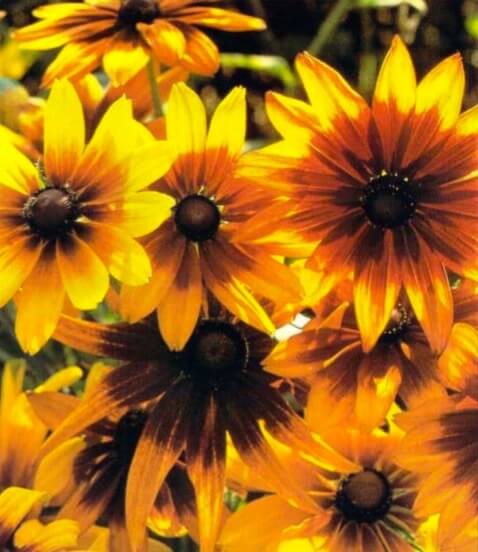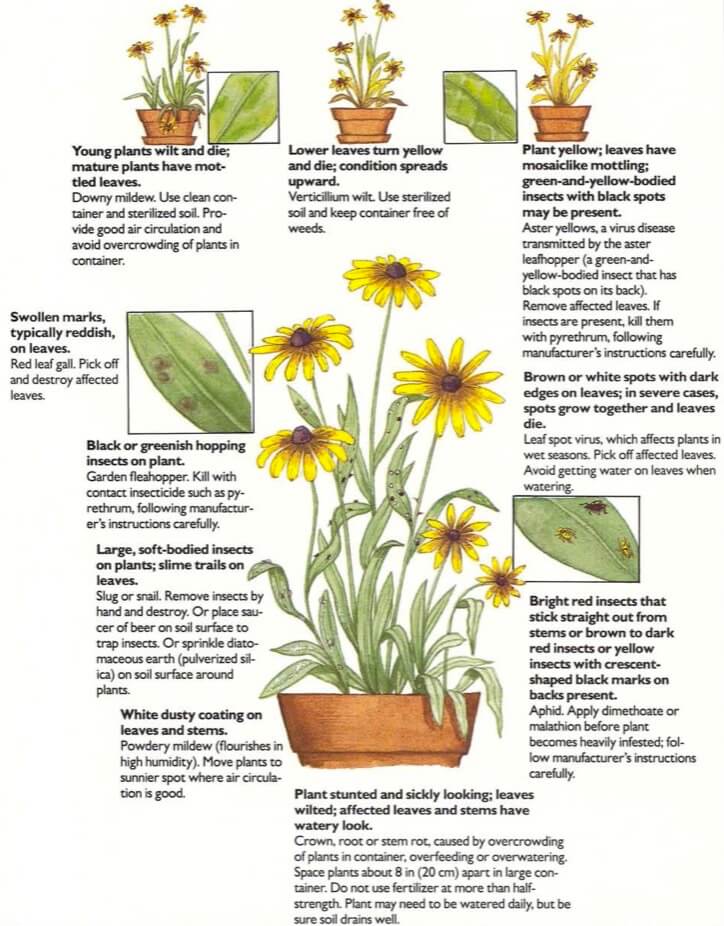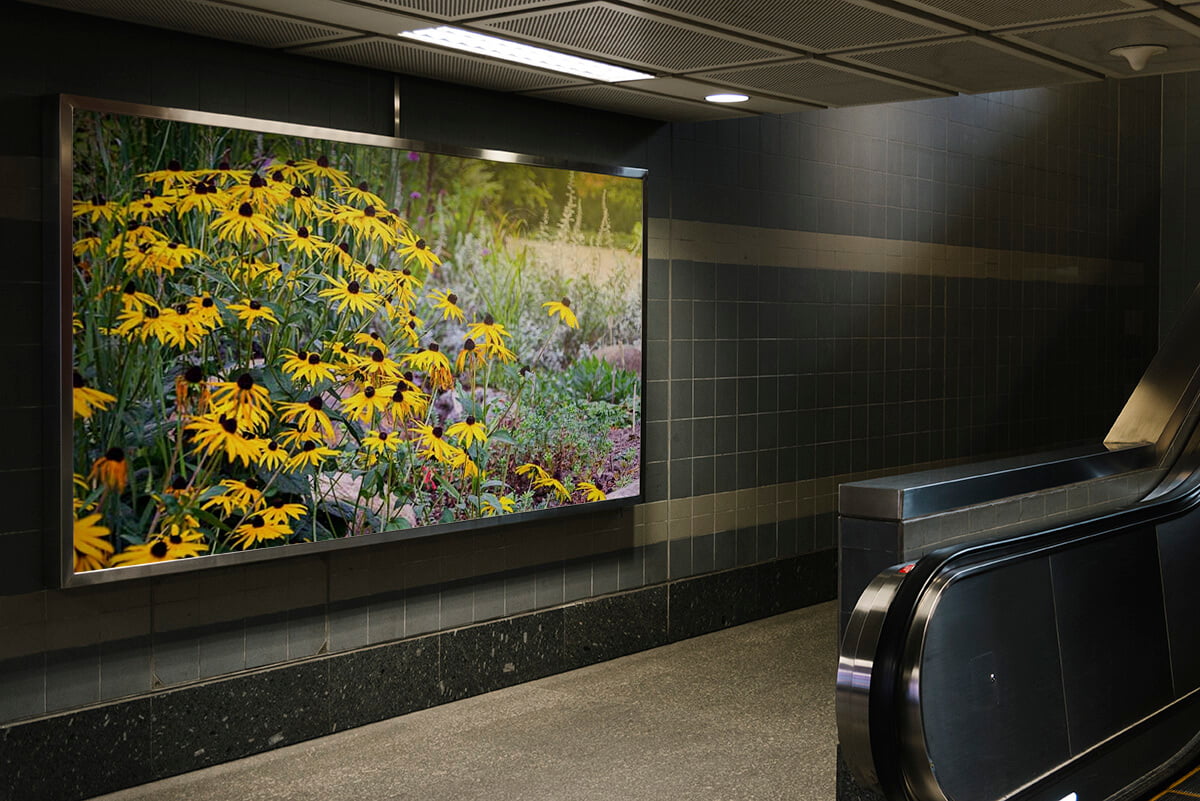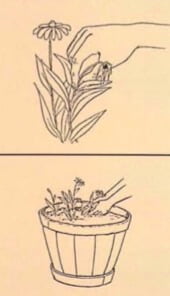[Ebook Việt Hoá] The Instant Guide to Healthy Houseplants (Hướng dẫn tức thời để chăm cây trong nhà khoẻ mạnh), Tông Rudbeckia
[Ebook Việt Hoá] The Instant Guide to Healthy Houseplants: Rudbeckia hirta (Gloriosa daisy, Black-eyed Susan)
- Nguồn: [Ebook Việt Hoá] The Instant Guide to Healthy Houseplants (Hướng dẫn tức thời để chăm cây trong nhà khoẻ mạnh)
- Biên tập: Dũng Cá Xinh
- Biên dịch: Team Codai.net
English
Native to western states, the gloriosa daisy has become naturalized throughout the U. S. Its cheerful flowers are deep yellow or orange, sometimes shading to red- dish or purplish, with purplish-brown cones at the centers. Actually a short-lived perennial, Rudbeckia hirta can be grown successfully as an annual in a container because it blooms early the first year from seed. As a tub plant, the gloriosa daisy can grow to 3 feet (90 cm), provided the container is large enough and the plant has at least a half day of full sunlight each day.

Light
Needs full sunlight for a minimum of 6 hours a day.
Temperature
Thrives in summer heat. Set young plants in containers outdoors after all danger of frost has passed. Mature plants will survive light frosts and continue to flower.
Water
Water when soil surface is dry (as often as daily in summer heat or when conditions are windy) .
Feeding
Feed young plants with half-strength, water-soluble flowering plant food every other week. After blooming starts, feed weekly, still at half-strength.
Starting from seed
For earliest blooms, sow seed indoors 4-6 weeks before last expected frost with sterile seed-starting mix in trays or shallow pots. Lightly cover seed with mix. Set tray or pots in tepid water until soil surface is damp, then place tray or pots under fluorescent lights or on a windowsill. After germination, move seedlings into strongest light available. When seedlings have a few leaves, transplant them to individual pots or thin out to 2 in (5 em) apart in tray. Before transplanting plants to final container, harden them off by placing them outdoors in a protected, shaded spot for 2-3 hours a day. Gradually increase time outdoors and move by stages into direct sun. After 10 days, transplant plants to permanent summer container.
Soil
Use sterilized, fertile soil that provides good drainage. If using commercial potting soil, add 1 part sand and 1 part peat moss to 2 parts potting soil.
Pruning
Deadhead (remove spent flowers) regularly.
Container
Use as large a patio pot as possible. A half-barrel is ideal; space plants 8 in (20 cm) apart.
What Goes Wrong

- Young plants wilt and die; mature plants have mottled leaves: Downy mildew. Use clean container and sterilized soil. Provide good air circulation and avoid overcrowding of plants in container.
- Swollen marks, typically reddish, on leaves: Red leaf gall. Pick off and destroy affected leaves.
- Black or greenish hopping insects on plant: Garden fleahopper. Kill with contact insecticide such as pyrethrum, following manufacturer’s instructions carefully.
- Large, soft-bodied insects on plants; slime trails on leaves: Slug or snail. Remove insects by hand and destroy. Or place saucer of beer on soil surface to trap insects. Or sprinkle diatomaceous earth (pulverized silica) on soil surface around plants .
- White dusty coating on leaves and stems: Powdery mildew (flourishes in high humidity). Move plants to sunnier spot where air circulation is good.
- Plant yellow; leaves have mosaic like mottling; green-and-yellow-bodied insects with black spots may be present: Aster yellows, a virus disease transmitted by the aster leafhopper (a green-and-yellow-bodied insect that has black spots on its back). Remove affected leaves. If insects are present, kill them with pyrethrum, following manufacturer’s instructions carefully.
- Brown or white spots with dark edges on leaves; in severe cases, spots grow together and leaves die: Leaf spot virus, which affects plants in wet seasons. Pick off affected leaves.
- Bright red insects that stick straight out from stems or brown to dark red insects o r yellow insects with crescent-shaped black marks on backs present: Aphid. Apply dimethoate or malathion before plant becomes heavily infested; follow manufacturer’s instructions carefully.
- Lower leaves turn yellow and die; condition spreads upward: Verticillium wilt. Use sterilized soil and keep container free of weeds.
- Plant stunted and sickly looking; leaves wilted; affected leaves and stems have watery look: Crown, root or stem rot, caused by overcrowding of plants in container, overfeeding or overwatering. Space plants about 8 in (20 cm) apart in large container.
Tiếng Việt
Có nguồn gốc từ các bang phía Tây, Cúc Gloriosa đã được hợp thủy thổ trên khắp nước Mỹ. Những bông hoa tươi vui có màu vàng đậm hoặc màu cam, đôi khi chuyển sang màu đỏ hoặc tía, với các hình nón màu nâu tía ở tâm. Trên thực tế, cây sống lâu năm ngắn ngày, Rudbeckia hirta có thể được trồng thành công hàng năm trong chậu vì nó nở hoa sớm vào năm đầu tiên từ hạt. Là một cây trồng trong bồn, Cúc Gloriosa có thể phát triển đến 3 feet (90 cm), miễn là chậu đủ rộng và hàng ngày cây có ít nhất nửa ngày tiếp xúc đầy đủ ánh sáng mặt trời.

Ánh sáng
Cần ánh sáng mặt trời đầy đủ tối thiểu 6 tiếng một ngày.
Nhiệt độ
Phát triển nhanh trong cái nóng bức của mùa hè. Đặt cây non trong chậu ở ngoài trời sau khi đã hết sương giá. Cây trưởng thành sẽ sống sót sau sương giá nhẹ và tiếp tục ra hoa.
Nước
Tưới nước khi bề mặt đất khô (hàng ngày vào mùa hè nắng nóng hoặc khi có gió).
Bón phân
Sử dụng phân bón cho cây ra hoa hòa tan trong nước và bón cho cây non mỗi tuần một lần. Sau khi bắt đầu nở hoa, bón phân hàng tuần, vẫn một nửa nồng độ.
Trồng cây từ hạt giống
Để có hoa nở sớm nhất, hãy gieo hỗn hợp hạt giống vô trùng vào khay hoặc chậu nông trong nhà từ 4-6 tuần trước khi sương giá kết thúc hoàn toàn. Phủ nhẹ hạt lên hỗn hợp đất. Đặt khay hoặc chậu trong nước ấm cho đến khi bề mặt đất ẩm, sau đó đặt khay hoặc chậu dưới đèn huỳnh quang hoặc trên bệ cửa sổ. Sau khi nảy mầm, di chuyển cây con vào nơi có ánh sáng mạnh nhất. Khi cây con ra một vài lá, chuyển sang các chậu riêng lẻ hoặc dàn mỏng cách nhau 2 inch (5 cm) trong khay. Trước khi chuyển cây vào thùng cuối cùng, hãy làm cứng chúng bằng cách đặt chúng ngoài trời ở nơi có bóng râm trong 2-3 giờ một ngày. Tăng dần thời gian ở ngoài trời và di chuyển theo từng giai đoạn ra nắng trực tiếp. Sau 10 ngày, chuyển cây vào thùng cố định cho mùa hè.
Đất
Sử dụng đất màu mỡ đã khử trùng có khả năng thoát nước tốt. Nếu sử dụng đất thương mại, thêm 1 phần cát và 1 phần than bùn vào 2 phần đất bầu.
Cắt tỉa
Cắt tỉa hoa tàn (loại bỏ hoa héo) thường xuyên.
Khay trồng
Sử dụng một khay bên trong càng lớn càng tốt. Một nửa khay là lý tưởng; các cây cách nhau 8 inch (20 cm).
Những vấn đề có thể xảy ra

- Cây non bị héo và chết; cây trưởng thành có đốm lá: Bệnh sương mai. Sử dụng khay chứa sạch và đất đã khử trùng. Cung cấp sự lưu thông không khí tốt và tránh để quá nhiều cây trong khay chứa.
- Các vết sưng màu đỏ trên lá: Mụn lá đỏ. Nhặt và tiêu hủy các lá bị ảnh hưởng.
- Côn trùng nhảy màu đen hoặc hơi xanh trên cây: Bọ chét vườn. Diệt bằng thuốc diệt côn trùng tiếp xúc như pyrethrum, theo hướng dẫn của nhà sản xuất một cách cẩn thận.
- Côn trùng lớn, thân mềm trên thực vật; các vệt chất nhờn trên lá: Sên hoặc ốc sên. Loại bỏ côn trùng bằng tay và tiêu diệt. Hoặc đặt bẫy bia trên bề mặt đất để bẫy côn trùng. Hoặc rắc diatomaceous earth (silica nghiền thành bột) lên bề mặt đất xung quanh cây.
- Bụi trắng phủ trên lá và thân: Bệnh phấn trắng (phát triển mạnh ở độ ẩm cao). Di chuyển cây đến chỗ có nhiều nắng hơn, nơi không khí lưu thông tốt.
- Cây màu vàng; lá có khảm như đốm; Các loại côn trùng thân xanh và vàng với các đốm đen xuất hiện: Aster yellows, một loại bệnh do vi rút truyền qua rầy nâu (một loại côn trùng thân xanh và vàng có đốm đen trên lưng). Loại bỏ các lá bị ảnh hưởng. Nếu có côn trùng, hãy diệt chúng bằng pyrethrum theo hướng dẫn của nhà sản xuất một cách cẩn thận.
- Các đốm nâu hoặc trắng với các viền sẫm trên lá; trong trường hợp nặng, các đốm mọc cùng nhau và lá chết: Virus đốm lá, ảnh hưởng đến cây trồng trong mùa mưa. Nhặt bỏ những lá bị ảnh hưởng.
- Các loại côn trùng màu đỏ tươi thò thẳng ra từ thân cây hoặc từ màu nâu đến màu đỏ sẫm. Các loài côn trùng màu vàng có vết đen hình lưỡi liềm trên lưng xuất hiện: Rệp. Bón dimethoate hoặc malathion trước khi cây bị nhiễm bệnh nặng; làm theo hướng dẫn của nhà sản xuất một cách cẩn thận.
- Các lá phía dưới chuyển sang màu vàng và chết; tình trạng lan lên trên: Héo do nấm Verticillium. Sử dụng đất đã khử trùng và giữ cho khay chứa không có cỏ dại.
- Cây còi cọc, ốm yếu; lá héo úa; lá và thân bị ảnh hưởng bị chảy nước: Thối đỉnh, rễ hoặc thân, do quá nhiều cây trong khay chứa, bón phân quá nhiều hoặc tưới quá nhiều. Các cây cách nhau khoảng 8 inch (20 cm) trong thùng lớn.




